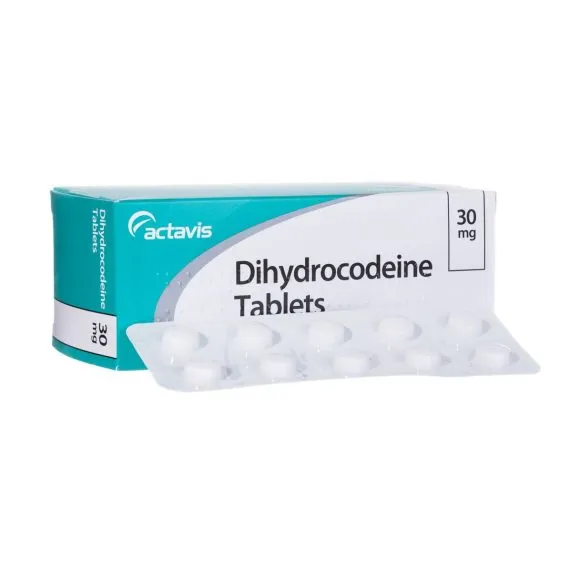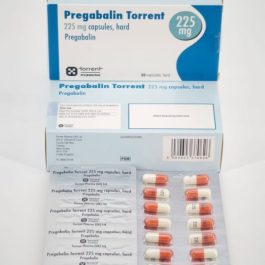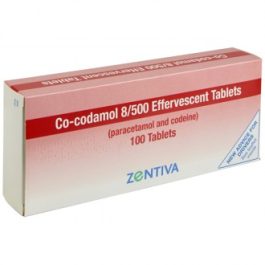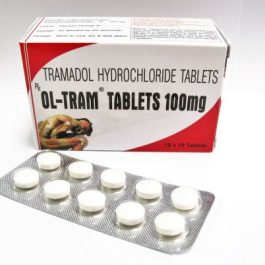Buy Dihydrocodeine 30mg Tablets
What is Dihydrocodeine?
Dihydrocodeine is a painkiller that comes under the class of semi-synthetic opioids. Dihydrocodeine is a semi-synthetic derivative of codeine with similar pharmacologic effects. Dihydrocodeine was developed in Germany in 1908 and first marketed in 1911 and its medical use was established in 1948. Dihydrocodeine is a drug originally developed as an effective drug for cough. Dihydrocodeine is used to treat moderate to severe pain such as pain after surgery or a serious injury, osteoarthritis, chronic rheumatoid arthritis, arthritis of the spine, peripheral vascular disease, post-herpetic neuralgia, Paget’s disease, malignant disease, and post-operative pain.
Dihydrocodeine is the generic term for medicines sold under the brand names DHC Continus in the US, DF118 FORTE in the UK (manufactured by Napp Pharmaceuticals Ltd, Martindale Pharma, and an Ethypharm Group Company). Other brands available are Parlor SS, ZerLor, Parlor DC.
Dihydrocodeine is also used for prolonged pain when less potent painkillers, such as paracetamol, ibuprofen, and aspirin, have not worked. Dihydrocodeine is available as a prescription drug.
Countries like Australia, United States, Japan, and the United Arab Emirates banned the sale of medicines containing codeine, dihydrocodeine as over-the-counter (OTC) medicines.
Dihydrocodeine is available online with a prescription. You can buy Dihydrocodeine online from Just-pills.com.
Dihydrocodeine comes as a tablet, capsule, and oral suspensions. Dihydrocodeine is also available in some countries as an injectable solution for deep subcutaneous and intramuscular administration.
Dihydrocodeine is also available in combination with NSAIDS which is indicated for severe painful conditions. Dihydrocodeine is available in fast-acting (liquid form), slow-release, standard release forms which will be prescribed according to the medical condition. Dihydrocodeine fast-acting takes a time period of 30 to 60 minutes to work. Standard tablets take between 1.5 and 2 hours to work fully. Slow-acting tablets may take a little longer to work but will last longer.
Dihydrocodeine tablets and capsules are available in 5 different strengths 30mg, 40mg, 60mg, 90 mg, 120 mg. Dihydrocodeine fast-acting tablets are available in strengths 30 mg, 40mg. Dihydrocodeine slow-acting tablets 60mg, 90 mg, 120 mg which are usually prescribed strength between 60mg to 90mg.
Dihydrocodeine is not indicated in some people who are diagnosed with certain medical conditions. Inform your doctor before starting the medicine if you had an allergic reaction using dihydrocodeine or any other medicine, stomach problems like irritable bowel syndrome (IBS) or Crohn’s disease, have lung problems, asthma or breathing difficulties, head injury, raised intracranial pressure, seizures or fits, hypothyroidism(less active thyroid gland), enlarged prostate, difficulty urinating, gland, low blood pressure, addiction to alcohol, liver or kidney problems, myasthenia gravis(a condition that causes muscle weakness, are trying to become pregnant, are already pregnant or are breastfeeding, are under 18 years and have had your tonsils or adenoids removed to treat obstructive sleep apnoea(breathlessness during sleep), have galactose intolerance problems.
The most frequently observed side effects of dihydrocodeine include allergy, light-headedness, dizziness, drowsiness, headache, fatigue, sedation, sweating, nausea, vomiting, constipation, pruritus, and skin reactions.
Drug interactions may change how your medications work or increase your risk for- serious side effects. Keep a list of all the products you use (including prescription/nonprescription drugs and herbal products) and share it with your doctor and pharmacist. Do not start, stop, or change the dosage of any medicines without your doctor’s approval.
Some products that may interact with dihydrocodeine include acetazolamide, antacids, anticholinergic medications (such as scopolamine), certain antibiotics (including penicillin, sulfonamides such as sulfamethoxazole), certain anti-seizure medications (such as valproic acid), certain drugs used to treat gout (including uricosuric drugs such as probenecid, sulfinpyrazone), cimetidine, corticosteroids (like prednisone), cancer drugs like (6-mercaptopurine, methotrexate, mifepristone, naltrexone, other medications for pain (such as pentazocine, morphine). Dihydrocodeine may increase the risk of bleeding when taken with other drugs that also may cause bleeding. Examples include anti-platelet drugs such as clopidogrel, “blood thinners” such as dabigatran/enoxaparin/warfarin, among others. Anxiolytics, hypnotic, antidepressants, and antihistamines enhance the CNS depressive effects when taken with dihydrocodeine. Alcohol, antipsychotics enhance the hypotensive, sedative effect, and respiratory depression when taken with dihydrocodeine.
Dihydrocodeine tablets should be administered with caution in patients with a history of opiate abuse or dependence. Patients may develop tolerance to the drug with prolonged use and require a gradual increase in doses to maintain pain control. Suddenly stopping dihydrocodeine tablets may cause withdrawal symptoms, especially if you have used it for a long time or in high doses. To prevent withdrawal, your doctor may lower your dose slowly. Tell your doctor or pharmacist right away if you have any withdrawal symptoms such as restlessness, difficulty in sleeping, irritability, agitation, anxiety, feeling your heartbeat (palpitations), increased blood pressure, feeling or being sick, diarrhea, shaking, shivering, or sweating.
Overdose of dihydrocodeine can cause central nervous system depression, including respiratory depression, extreme somnolence progressing to stupor or coma, skeletal muscle flaccidity, cold and clammy skin.
The triad of coma, pinpoint pupils and respiratory depression is considered indicative of opioid overdosage with dilation of the pupils occurring as hypoxia develops. Nausea and vomiting are common. Other opioid overdose symptoms include hypothermia, confusion, convulsions, severe dizziness, severe drowsiness, hypotension and tachycardia (possible but unlikely), nervousness or restlessness, excitement, hallucinations, bradycardia, hypotension, circulatory failure, slow or troubled breathing, severe weakness, convulsions, especially in infants and children. In severe overdose with codeine, apnoea, circulatory collapse, cardiac arrest and even death may occur. If you see someone who has been overdosed with dihydrocodeine, within the first hour of intake, activated charcoal should be given, naloxone (which is an antagonist medicine that works against and normalizes the adverse action of dihydrocodeine) should be administered if respiratory depression is evident
Bioavailability is low (approximately 20%) if administered orally. The peak level of the drug in plasma occurs 1.6 – 1.8 hours after ingestion. This may be due to poor gastrointestinal absorption. It is also likely due to pre-systemic metabolism by the liver and intestinal wall. Dihydrocodeine undergoes renal elimination and is excreted in the urine as an unchanged drug.
Dihydrocodeine tablets may affect one’s thinking and reasoning efficiency. Dizziness, spinning sensations, muscle rigidity, visual disturbances, drowsiness, confusion, fainting, or hallucinations are some of the effects that you may experience. Do not drive or operate machinery if affected.
Dihydrocodeine tablets are white circular biconvex uncoated tablets. Each tablet contains a Dihydrocodeine tartrate variable dose. The other ingredients are colloidal silica, lactose monohydrate, magnesium stearate, maize starch, microcrystalline cellulose. It is important to store dihydrocodeine below 30°C and protect it from light and moisture. Keep out of reach of children. Unused dihydrocodeine tablets should not be discarded as domestic waste rather it should be returned to the pharmacy so that they will discard it more efficiently.
How does Dihydrocodeine work?
The liver metabolizes dihydrocodeine into dihydromorphine which gives pain relief. In different people, this process of metabolism works at a different pace.
Dihydrocodeine produces their actions at a cellular level by activating opioid receptors (receptors in the central nervous system and brain that reduce pain). These receptors are distributed throughout the central nervous system (CNS) codeine binds to receptors in the brain (opioid receptors) causing a reduction in nerve cell excitability which in turn reduces the sensation of pain throughout the body and brain. Dihydrocodeine increases tolerance to pain. Although it reduces pain, dihydrocodeine also causes sedation, drowsiness, and depressed breathing. Controlled release dihydrocodeine tablets take 1.5 to 2 hours to work completely.
Benefits of Dihydrocodeine
Dihydrocodeine is used as an alternative to codeine. Dihydrocodeine provided better pain relief and was associated with fewer adverse effects in patients. Dihydrocodeine is chemically similar to the structure of codeine. Dihydrocodeine is more efficient than codeine and has twice the effect of codeine. Dihydrocodeine 100mg has an equivalent pain-relieving effect of morphine 10mg. Dihydrocodeine clearly possesses a stronger analgesic effect compared to tramadol.
Dihydrocodeine works rapidly, usually in less than 30 minutes, and can provide pain relief for up to 4 hours. Dihydrocodeine doses cause little or no respiratory depression in comparison with other opioids like morphine, codeine. DHC rarely causes nausea and vomiting and in most patients the drug is well-tolerated, therefore another drug to treat nausea and vomiting is not routinely recommended. Dihydrocodeine improves the psychological reaction to pain by reducing the associated anxiety. Dihydrocodeine is used in the treatment of post-operative pain in patients who has chronic heart failure. Dihydrocodeine is also used to treat dyspnoea (shortness of breath). Dihydrocodeine combined with methylephedrine hydrochloride/ chlorpheniramine maleate are used to treat the cough in diseases such as acute bronchitis, chronic bronchitis, cold/upper respiratory inflammation, pneumonia, pulmonary tuberculosis. Dihydrocodeine is one of the choices of drugs that is placed at the second step of the WHO analgesic ladder (three-step ladder for cancer pain relief in adults) as a ‘weak’ opioid. Dihydrocodeine is used to relieve pain in cancer patients. Dihydrocodeine is used for the detoxification of methadone (an opioid drug that is used for opioid maintenance therapy and chronic pain management). Detoxification using methadone can be accomplished in less than a month, or it may be done gradually over as long as six months with the help of dihydrocodeine.
In contrast to tramadol, dihydrocodeine has less risk of appearing of serotonin syndrome (a condition that causes potentially fatal and too much nerve activity) in severe cases, it may cause muscle rigidity, fever and seizures, and even death.
How to take Dihydrocodeine?
Before starting the treatment with opioids, a thorough discussion should be held with the physician to avoid the risk of addiction and drug withdrawal syndrome. Swallow the tablet or capsule with a full glass of water (8 ounces or 240 milliliters). The standard release tablets must be swallowed whole, and must not be broken, chewed, or crushed. The intake of broken, chewed, or crushed controlled-release tablets lead to a rapid release and absorption of dihydrocodeine and may result in potentially fatal overdose effects. You should not lie down for at least 10 minutes after taking Codeine. If you have a vomiting sensation it’s advised to take codeine with food.
An initial dose of 20-35mg may usually be given to most adults with safety; but, as always, the weight, condition, and age of the patient must be taken into consideration. The elderly should also follow the dosage instructions of their doctor as the standard dose may be reduced.
Dihydrocodeine is not recommended in children under 4 years and for children aged 4-12 years and teenagers, the dosage as instructed by the doctor must be followed, in geriatric patient’s dosage is usually reduced.
The usual dose for adults and children aged 12 years and over is: Dihydrocoedeine 30mg tablet – 1 or 2 tablets every 4 to 6 hours – maximum dose in 24 hours is 6 tablets (180mg) 40mg tablet – 1 or 2 tablets up to 3 times in 24 hours – maximum dose in 24 hours is 6 tablets (240mg).
The usual dose of dihydrocodeine oral suspension is 1 to 3 5ml taken every 4 to 6 hours. One 5ml full spoon has 10mg of dihydrocodeine in it (3 spoonfuls contain 30mg).
For children aged between 4 and 11 years dose is worked out based on weight. The usual dose is between 0.5mg and 1mg per kg of body weight, up to a maximum dose of 30mg every 4 to 6 hours.
While buying dihydrocodeine oral suspension the manufacture will provide a medicine spoon to help you measure the correct amount. Ask a pharmacist for one if you do not have it. Do not use a kitchen teaspoon to measure the liquid because it will not give the correct amount.
The duration of treatment with dihydrocodeine should not be extended beyond three days and if no effective pain relief is achieved then patients should take necessary advice from their physician but you may need to take it for longer if you have a long-term illness such as cancer.
If you missed a dose of dihydrocodeine take the missed dose as soon as you remember it. However, if it is almost time for the next dose, skip the missed dose and continue the regular dosing schedule. Do not take a double dose to make up for a missed one. It’s better to set an alarm if you often have the habit of forgetting to take your medicine on time.






Reviews
There are no reviews yet.